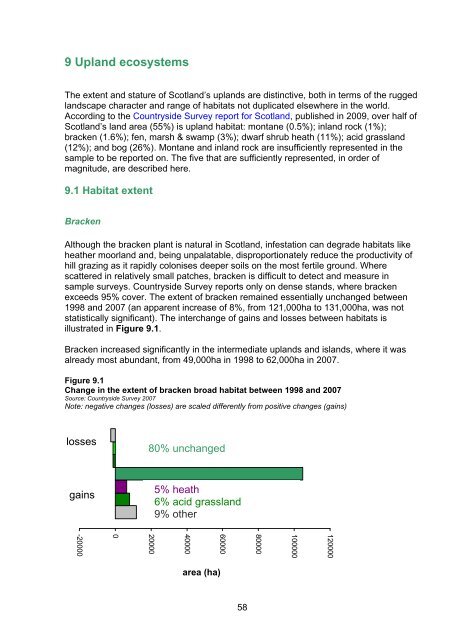Scotland's Wildlife â an assessment of biodiversity in 20
Scotland's Wildlife â an assessment of biodiversity in 20
Scotland's Wildlife â an assessment of biodiversity in 20
Create successful ePaper yourself
Turn your PDF publications into a flip-book with our unique Google optimized e-Paper software.
9 Upl<strong>an</strong>d ecosystems<br />
The extent <strong>an</strong>d stature <strong>of</strong> Scotl<strong>an</strong>d’s upl<strong>an</strong>ds are dist<strong>in</strong>ctive, both <strong>in</strong> terms <strong>of</strong> the rugged<br />
l<strong>an</strong>dscape character <strong>an</strong>d r<strong>an</strong>ge <strong>of</strong> habitats not duplicated elsewhere <strong>in</strong> the world.<br />
Accord<strong>in</strong>g to the Countryside Survey report for Scotl<strong>an</strong>d, published <strong>in</strong> <strong>20</strong>09, over half <strong>of</strong><br />
Scotl<strong>an</strong>d’s l<strong>an</strong>d area (55%) is upl<strong>an</strong>d habitat: mont<strong>an</strong>e (0.5%); <strong>in</strong>l<strong>an</strong>d rock (1%);<br />
bracken (1.6%); fen, marsh & swamp (3%); dwarf shrub heath (11%); acid grassl<strong>an</strong>d<br />
(12%); <strong>an</strong>d bog (26%). Mont<strong>an</strong>e <strong>an</strong>d <strong>in</strong>l<strong>an</strong>d rock are <strong>in</strong>sufficiently represented <strong>in</strong> the<br />
sample to be reported on. The five that are sufficiently represented, <strong>in</strong> order <strong>of</strong><br />
magnitude, are described here.<br />
9.1 Habitat extent<br />
Bracken<br />
Although the bracken pl<strong>an</strong>t is natural <strong>in</strong> Scotl<strong>an</strong>d, <strong>in</strong>festation c<strong>an</strong> degrade habitats like<br />
heather moorl<strong>an</strong>d <strong>an</strong>d, be<strong>in</strong>g unpalatable, disproportionately reduce the productivity <strong>of</strong><br />
hill graz<strong>in</strong>g as it rapidly colonises deeper soils on the most fertile ground. Where<br />
scattered <strong>in</strong> relatively small patches, bracken is difficult to detect <strong>an</strong>d measure <strong>in</strong><br />
sample surveys. Countryside Survey reports only on dense st<strong>an</strong>ds, where bracken<br />
exceeds 95% cover. The extent <strong>of</strong> bracken rema<strong>in</strong>ed essentially unch<strong>an</strong>ged between<br />
1998 <strong>an</strong>d <strong>20</strong>07 (<strong>an</strong> apparent <strong>in</strong>crease <strong>of</strong> 8%, from 121,000ha to 131,000ha, was not<br />
statistically signific<strong>an</strong>t). The <strong>in</strong>terch<strong>an</strong>ge <strong>of</strong> ga<strong>in</strong>s <strong>an</strong>d losses between habitats is<br />
illustrated <strong>in</strong> Figure 9.1.<br />
Bracken <strong>in</strong>creased signific<strong>an</strong>tly <strong>in</strong> the <strong>in</strong>termediate upl<strong>an</strong>ds <strong>an</strong>d isl<strong>an</strong>ds, where it was<br />
already most abund<strong>an</strong>t, from 49,000ha <strong>in</strong> 1998 to 62,000ha <strong>in</strong> <strong>20</strong>07.<br />
Figure 9.1<br />
Ch<strong>an</strong>ge <strong>in</strong> the extent <strong>of</strong> bracken broad habitat between 1998 <strong>an</strong>d <strong>20</strong>07<br />
Source: Countryside Survey <strong>20</strong>07<br />
Note: negative ch<strong>an</strong>ges (losses) are scaled differently from positive ch<strong>an</strong>ges (ga<strong>in</strong>s)<br />
losses<br />
80% unch<strong>an</strong>ged<br />
ga<strong>in</strong>s<br />
5% heath<br />
6% acid grassl<strong>an</strong>d<br />
9% other<br />
1<strong>20</strong>000<br />
100000<br />
80000<br />
60000<br />
40000<br />
<strong>20</strong>000<br />
0<br />
-<strong>20</strong>000<br />
area (ha)<br />
58
















